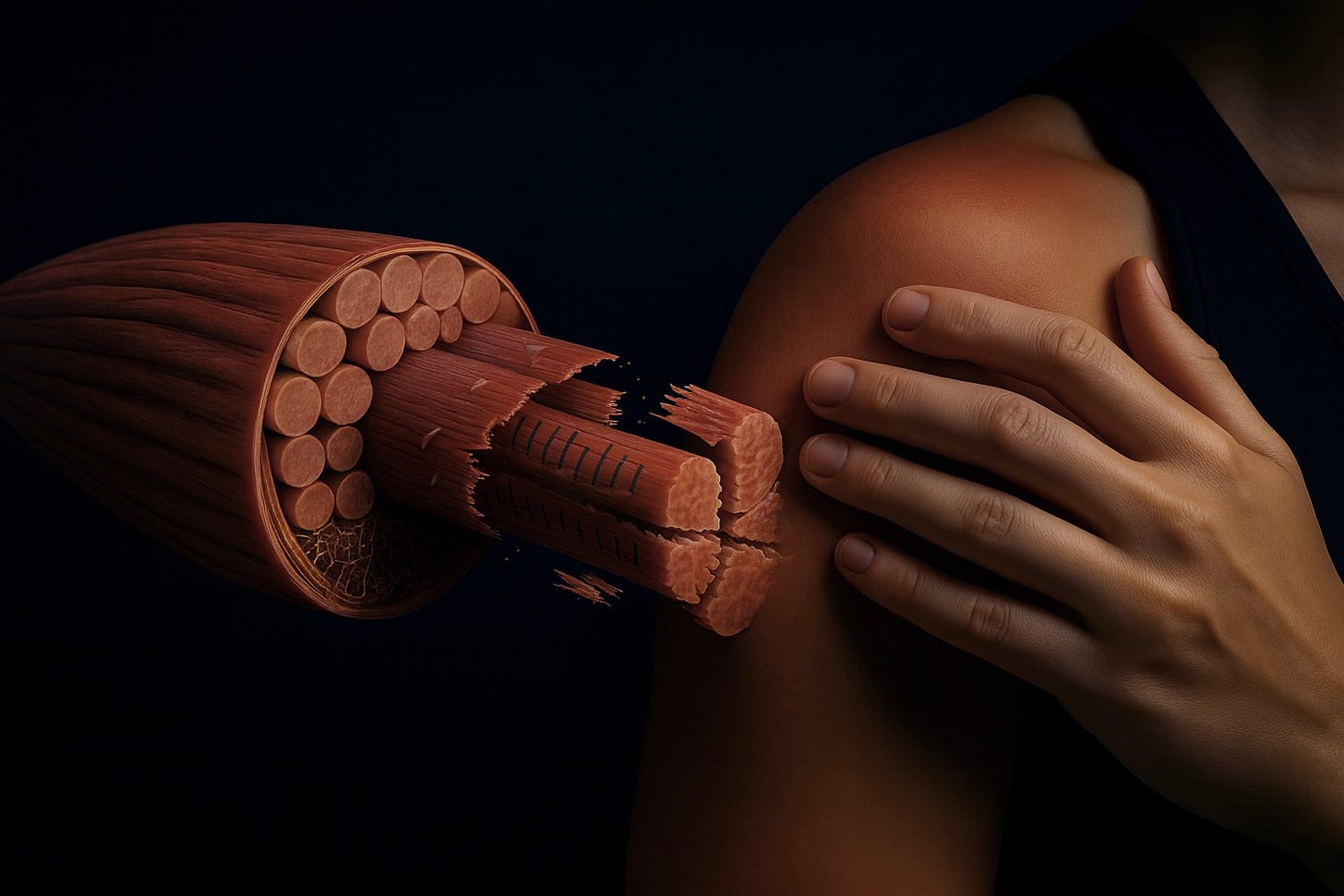DOMS Explained: Why We Get Sore and What It Really Means
From sarcomere damage to immune clean-up crews — the real biology of soreness.
1. Why does soreness happen?
DOMS = Delayed Onset Muscle Soreness. It’s not lactic acid. It’s structural stress.
At the fibre level. Eccentric contractions (lowering weight) stretch sarcomeres past their limit → Z-discs “pop” and tear.
At the cell level. This disruption leaks calcium from the sarcoplasmic reticulum, interfering with contraction + activating enzymes that worsen damage.
At the tissue level. Damaged fibres release cytokines → neutrophils + macrophages rush in → inflammation, swelling, pain receptor sensitisation.
At the system level. Nociceptors fire = you feel sore, stiff, and weaker for a few days.
👉 Soreness = controlled micro-damage → immune clean-up → repair + adaptation.
2. Is soreness a bad thing?
No (if mild/moderate). It’s your body adapting to new stress.
Yes (if extreme). Too much = risk of injury, poor recovery, or even rhabdomyolysis (rare, but dangerous).
So soreness isn’t inherently “bad” — but constant or severe soreness = a red flag your balance (load vs recovery) is off.
3. How long should soreness last?
Normal DOMS: kicks in 12–24h after training, peaks 48h, fades in 3–4 days.
Warning signs: lasts >5–7 days, sharp/stabbing pain, joint pain instead of muscle, or swelling that limits movement.
👉 Duration = balance of microtrauma vs repair. If you’re fuelling/sleeping well, recovery speeds up.
4. Should I rest completely?
Movement helps. Deep rest (lying still) slows recovery → less circulation = slower clean-up.
Active recovery works better. Light movement (walking, gentle cycling, mobility work) increases blood flow → faster waste clearance and nutrient delivery.
Training the sore muscle? You can, but keep intensity lighter until soreness resolves. Think circulation > strain.
5. Nutrition + sleep: do they matter, really?
Yes — but here’s why at the cellular level:
Protein. Provides amino acids → rebuilds disrupted sarcomeres, activates satellite cells for repair.
Hydration. Improves plasma volume → faster nutrient delivery + waste removal → less inflammation pooling.
Sleep. During deep sleep, growth hormone + IGF-1 spike → activate satellite cells + protein synthesis → repair accelerates.
👉 Without these, immune clean-up is slower, fibres stay disrupted longer, and soreness lingers.
6. The repair heroes: satellite cells
Satellite cells = muscle stem cells. They sit dormant around the fibre until stress wakes them up.
After damage, they proliferate and fuse to fibres.
They donate new nuclei, giving the muscle greater capacity for protein synthesis.
This not only repairs but also upgrades the fibre for future loads.
👉 DOMS pain fades in days, but the satellite cell contribution lingers — setting you up for long-term growth.
7. Why soreness fades over time (Repeated Bout Effect)
First exposure: lots of disruption, soreness, temporary weakness.
Subsequent exposures: fibres remodel (stronger cytoskeleton, more connective tissue), circulation improves, and your nervous system coordinates better.
Result: the same workout weeks later = less soreness, more strength.
8. Myth mini-break
Myth: DOMS is lactic acid.
Fact: Lactate clears within an hour of exercise. DOMS peaks 1–2 days later.
Myth: If you’re not sore, you didn’t work hard.
Fact: Adaptation means less soreness for the same or greater gains.
9. When to be concerned
Soreness + swelling that doesn’t fade.
Pain in joints, not muscles → likely injury.
DOMS = discomfort. Injury = dysfunction. Know the difference.
Bottom line
Soreness isn’t a medal. It’s biology’s way of saying “we weren’t ready, but now we’re adapting.”
At the cellular level, it’s disruption → inflammation → immune clean-up → satellite cell repair.
At the practical level, it lasts a few days, gets lighter with consistency, and fades fastest when you fuel, hydrate, sleep, and keep moving.
DOMS isn’t proof of growth — it’s the biology of disruption, repair, and adaptation. The ache fades, the adaptation stays.

